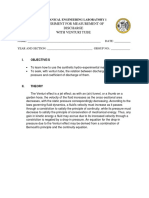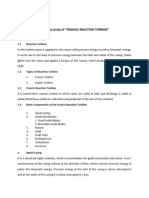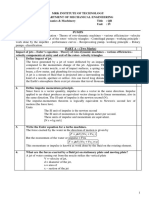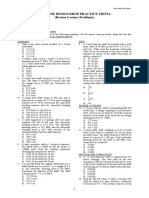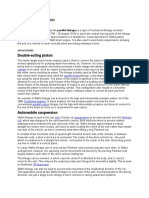0 ratings0% found this document useful (0 votes)
424 viewsExperiment # 2: 90 V-Notch Weir
Experiment # 2: 90 V-Notch Weir
Uploaded by
Jerome BalatbatExperiment #2 aims to determine the coefficient of discharge for a 90-degree triangular notch weir and examine the relationship between discharge and water head. The experiment uses a pump, sluice valves, hook gauge, triangular weir, waterway, and main tank. Water is supplied and head measurements are taken at steady flows and recorded. Discharge is then calculated using the coefficient of discharge equation and plotted against head to analyze the relationship.
Copyright:
© All Rights Reserved
Available Formats
Download as DOCX, PDF, TXT or read online from Scribd
Experiment # 2: 90 V-Notch Weir
Experiment # 2: 90 V-Notch Weir
Uploaded by
Jerome Balatbat0 ratings0% found this document useful (0 votes)
424 views2 pagesExperiment #2 aims to determine the coefficient of discharge for a 90-degree triangular notch weir and examine the relationship between discharge and water head. The experiment uses a pump, sluice valves, hook gauge, triangular weir, waterway, and main tank. Water is supplied and head measurements are taken at steady flows and recorded. Discharge is then calculated using the coefficient of discharge equation and plotted against head to analyze the relationship.
Original Description:
This document serves as a brief report in a weir experiment.
Original Title
NOTCHE
Copyright
© © All Rights Reserved
Available Formats
DOCX, PDF, TXT or read online from Scribd
Share this document
Did you find this document useful?
Is this content inappropriate?
Experiment #2 aims to determine the coefficient of discharge for a 90-degree triangular notch weir and examine the relationship between discharge and water head. The experiment uses a pump, sluice valves, hook gauge, triangular weir, waterway, and main tank. Water is supplied and head measurements are taken at steady flows and recorded. Discharge is then calculated using the coefficient of discharge equation and plotted against head to analyze the relationship.
Copyright:
© All Rights Reserved
Available Formats
Download as DOCX, PDF, TXT or read online from Scribd
Download as docx, pdf, or txt
0 ratings0% found this document useful (0 votes)
424 views2 pagesExperiment # 2: 90 V-Notch Weir
Experiment # 2: 90 V-Notch Weir
Uploaded by
Jerome BalatbatExperiment #2 aims to determine the coefficient of discharge for a 90-degree triangular notch weir and examine the relationship between discharge and water head. The experiment uses a pump, sluice valves, hook gauge, triangular weir, waterway, and main tank. Water is supplied and head measurements are taken at steady flows and recorded. Discharge is then calculated using the coefficient of discharge equation and plotted against head to analyze the relationship.
Copyright:
© All Rights Reserved
Available Formats
Download as DOCX, PDF, TXT or read online from Scribd
Download as docx, pdf, or txt
You are on page 1of 2
EXPERIMENT # 2: 90⁰ V-NOTCH WEIR
Objective:
-To find the coefficient of discharge through a 90⁰ triangular notch
-To seek the relation between discharge and water head for weirs of 90-degrees.
Apparatus: (The Synthetic Hydro-Experimental Machine)
1: pump
2,3: sluice valves
4: hook gauge
5: triangular weir of 90- degree
6: waterway
7: main tank
8: cock
Other Equipments needed:
1. Open channel stream
2. 90⁰ triangular notch (V-notch)
3. A constant water supply with a regulating valve to change discharge of
water.
4. Hook gauge to measure water level head.
5. Stopwatch
Procedure:
1. Check the tank if there are any leakages.
2. As water flows in the channel, measure the water head using the hook
gauge once the water has stabilized. Adjust the hook gauge to zero scale
before measuring water head.
3. At a steady flow rate, measure the head “H” of the water level by adjusting
the hook gauge and recording the reading.
4. Continue the process by measuring and recording different heads by
opening the valves and letting more water flow in.
Relative Equations:
a) Coefficient of Discharge
K = 81.2 + 0.24/H + [8.4 + (12/ D1/2 )] [ ( H/B ) – 0.09 ]2
where: H= Water head
D= Depth from the bottom of the waterway to the notch of the weir
B= Width of the waterway, 0.6m
b) Discharge
Q = KH5/2
where: K = coefficient of discharge
H = Water Head
Arrangement of Experimental Result
Create a graph of the relation between discharge and water head. Compare
between K given by the above equation and K given by the relation between
discharge and water head.
You might also like
- Experiment 7 DiagramDocument7 pagesExperiment 7 Diagramartemio john claveNo ratings yet
- Weirs (Autosaved)Document14 pagesWeirs (Autosaved)Danniel Dizon LanggaNo ratings yet
- Experiment 2 - Hydrostatic BenchDocument10 pagesExperiment 2 - Hydrostatic BenchUb Usoro100% (1)
- 2.venturimeter Theory PDFDocument9 pages2.venturimeter Theory PDFSWETHANo ratings yet
- Metacentric Height of Ship ModelDocument4 pagesMetacentric Height of Ship ModelmitulkindNo ratings yet
- Problems On Screws PDFDocument6 pagesProblems On Screws PDFJerome Balatbat100% (1)
- Emergency Response ProcedureDocument14 pagesEmergency Response ProcedureJerome Balatbat50% (2)
- Platform ScaleDocument3 pagesPlatform ScaleJerome BalatbatNo ratings yet
- Group Report Experiment VenturiDocument5 pagesGroup Report Experiment VenturiJerome BalatbatNo ratings yet
- Revised LabDocument18 pagesRevised LabAbu AyemanNo ratings yet
- User Manual Notch ApparatusDocument4 pagesUser Manual Notch Apparatusrohit kumarNo ratings yet
- Hydraulic Exp1Document15 pagesHydraulic Exp1FikrilAzimAbdulSaniNo ratings yet
- NotchesDocument15 pagesNotchesAshwin KhandelwalNo ratings yet
- Flow Over Rectangular and V - NotchesDocument7 pagesFlow Over Rectangular and V - NotchesAyoi Muhd0% (2)
- 1 Calibrating The Venturi Meter and Orifice MeterDocument5 pages1 Calibrating The Venturi Meter and Orifice MeterRaghavanNo ratings yet
- Reciprocating Pump Test RigDocument7 pagesReciprocating Pump Test RigPurtain MENo ratings yet
- Tutorial Sheet 7Document2 pagesTutorial Sheet 7AmyRapaNo ratings yet
- Exp 1-Hele ShawDocument1 pageExp 1-Hele Shawadityain2003100% (1)
- AIM: To Conduct Performance Test On A Single Stage Centrifugal Pump Test RigDocument4 pagesAIM: To Conduct Performance Test On A Single Stage Centrifugal Pump Test RigmuralidharanNo ratings yet
- Lab Manual 2 Rectangular and Triangular NotchesDocument8 pagesLab Manual 2 Rectangular and Triangular NotchesLeo KhanNo ratings yet
- Calibration of VenturimeterDocument5 pagesCalibration of VenturimeteramarparimiNo ratings yet
- Flow Over WeirsDocument4 pagesFlow Over WeirsZAXNo ratings yet
- Forced Vortex FlowDocument12 pagesForced Vortex FlowSaravin Selhvadurai100% (1)
- Lab Expt 04 - Investigation of Forced VorticesDocument5 pagesLab Expt 04 - Investigation of Forced VorticesGIANNE MARIE AZURINNo ratings yet
- Critical Reynolds Number in Pipe FlowDocument2 pagesCritical Reynolds Number in Pipe FlowHunterTateNo ratings yet
- Determination of Discharge by Use of The Pitot TubeDocument2 pagesDetermination of Discharge by Use of The Pitot TubeJoffer Gallamaso100% (4)
- Flow Visualization ExperimentDocument9 pagesFlow Visualization ExperimentPei Shan ChoongNo ratings yet
- Centrifugal Pump Test Rig (With A.C Motor, 3 Speed With Step Cone Pulley)Document9 pagesCentrifugal Pump Test Rig (With A.C Motor, 3 Speed With Step Cone Pulley)Sandeep SainiNo ratings yet
- Reciprocating - Pump - Lab Manual Ms WordDocument10 pagesReciprocating - Pump - Lab Manual Ms WordSandeep SainiNo ratings yet
- Venturimeter, Orificemeter & Rotameter Calibration Set-Up: Experiment No. 4Document9 pagesVenturimeter, Orificemeter & Rotameter Calibration Set-Up: Experiment No. 4Somya MaheshwariNo ratings yet
- Bi Quartz PolarimeterDocument3 pagesBi Quartz PolarimeterNikitaNo ratings yet
- Venturimeter Exp. 250412Document4 pagesVenturimeter Exp. 250412abhishekpatil21No ratings yet
- Fluid and Hydrostatic BenchDocument1 pageFluid and Hydrostatic BenchBalRam DhimanNo ratings yet
- Screw JackDocument3 pagesScrew Jackernest amponsahNo ratings yet
- Heat Engine-GTU-Sem-1Document78 pagesHeat Engine-GTU-Sem-1Khushank MNo ratings yet
- Experiment #3 Venturi Meter: Home Unquantized ProjectsDocument7 pagesExperiment #3 Venturi Meter: Home Unquantized ProjectsEddy KimathiNo ratings yet
- Fluid Mechanics 2 - Practical 1 Discharge Through An OrificeDocument13 pagesFluid Mechanics 2 - Practical 1 Discharge Through An OrificeShivesh Sohawan50% (4)
- FM-II Lab Experiment Pelton Turbine 01Document6 pagesFM-II Lab Experiment Pelton Turbine 01Umar JavedNo ratings yet
- Practical 2 To Make Study of "Francis Reaction Turbine"Document7 pagesPractical 2 To Make Study of "Francis Reaction Turbine"litrakhanNo ratings yet
- Lab Report 1 Tray DrierDocument7 pagesLab Report 1 Tray Drier_never_mind_100% (1)
- 5 - Velocity Distribution For Both Smooth and Rough PipesDocument24 pages5 - Velocity Distribution For Both Smooth and Rough PipesMustafa ZahidNo ratings yet
- Vapour in Air DiffussionDocument14 pagesVapour in Air DiffussionDEEPAK KUMAR100% (1)
- Chapter 5: Non Uniform Flow in Open ChannelDocument23 pagesChapter 5: Non Uniform Flow in Open ChannelShashank S100% (1)
- Manual of Four Cylinder Four Stroke Petrol Engine Test RigDocument16 pagesManual of Four Cylinder Four Stroke Petrol Engine Test RigDhruv Patel100% (1)
- Calibration of VenturimeterDocument5 pagesCalibration of VenturimeterRahul KumarNo ratings yet
- Calibrating The Venturi Meter and Orifice MeterDocument6 pagesCalibrating The Venturi Meter and Orifice MeterMUTHUKURU VENKATA GOWTHAM REDDY100% (1)
- Experiment:04 Cam Jump Analysis: Kinematics and Dynamics Lab Manual (ME406ES)Document15 pagesExperiment:04 Cam Jump Analysis: Kinematics and Dynamics Lab Manual (ME406ES)Akshay PolasNo ratings yet
- Discharge From A Triangular Notch PDFDocument2 pagesDischarge From A Triangular Notch PDFSouradeep SenNo ratings yet
- MTO - PROBLEM - SHEETS - 2and 3Document5 pagesMTO - PROBLEM - SHEETS - 2and 3MOHIT GUPTANo ratings yet
- Flumes - Water Engineering PDFDocument24 pagesFlumes - Water Engineering PDFMogie TalampasNo ratings yet
- V Sem Heat Transfer Lab ManualDocument4 pagesV Sem Heat Transfer Lab ManualoctoviancletusNo ratings yet
- Dead Wieght Pressure GaugeDocument3 pagesDead Wieght Pressure GaugeghambiraNo ratings yet
- Bernoulli's Theorem ApparatusDocument1 pageBernoulli's Theorem ApparatusBalRam DhimanNo ratings yet
- Manual of Four Cylinder Four Stroke Petrol Engine Test RigDocument18 pagesManual of Four Cylinder Four Stroke Petrol Engine Test RigSandeep SainiNo ratings yet
- Practical Verification of Bernoulli'S Theorem: StructureDocument3 pagesPractical Verification of Bernoulli'S Theorem: StructureVívék SâíNo ratings yet
- Hydraulics Sniper ReportDocument8 pagesHydraulics Sniper ReportKhumo Ezekiel MoraNo ratings yet
- FMM - Unit Iv QBDocument52 pagesFMM - Unit Iv QBThiruvasagamoorthy KaNo ratings yet
- Lab Report 5 - Hydrostatic Pressure On Plane Surfaces G2Document19 pagesLab Report 5 - Hydrostatic Pressure On Plane Surfaces G2Raziq HaiqalNo ratings yet
- FM Lab ManualDocument9 pagesFM Lab ManualAbhimanyu Singh BhatiNo ratings yet
- Experiment No. 2 To Determine The Discharge and Co-Efficient of Discharge Over A Rectangular NotchDocument4 pagesExperiment No. 2 To Determine The Discharge and Co-Efficient of Discharge Over A Rectangular NotchAjmal KhanNo ratings yet
- Fluid Mechanics Lab Laboratory Manual: Dev Bhoomi Institute Chakrata Road, Navgaoun Manduwala, UttarakhandDocument29 pagesFluid Mechanics Lab Laboratory Manual: Dev Bhoomi Institute Chakrata Road, Navgaoun Manduwala, Uttarakhandvihangam yoga chandauli100% (1)
- Lab Manual: Muzaffarpur Institute of Technology MuzaffarpurDocument22 pagesLab Manual: Muzaffarpur Institute of Technology MuzaffarpurGautam GunjanNo ratings yet
- Case Studies in Fluid Mechanics with Sensitivities to Governing VariablesFrom EverandCase Studies in Fluid Mechanics with Sensitivities to Governing VariablesNo ratings yet
- Problems On Screws PDFDocument6 pagesProblems On Screws PDFJerome BalatbatNo ratings yet
- BearingsDocument7 pagesBearingsJerome BalatbatNo ratings yet
- Notes - Lect 2 MMT (ME-294)Document22 pagesNotes - Lect 2 MMT (ME-294)Jerome BalatbatNo ratings yet
- The Minimum Ultimate Tensile Strength of No. 41 Lightweight Machinery Chain Is: A. 2000 LB B. 1000 LB C. 1800 LB D. 2500 LBDocument69 pagesThe Minimum Ultimate Tensile Strength of No. 41 Lightweight Machinery Chain Is: A. 2000 LB B. 1000 LB C. 1800 LB D. 2500 LBJerome BalatbatNo ratings yet
- Test No. 1Document51 pagesTest No. 1Jerome BalatbatNo ratings yet
- Machine Design/Shop Practice Trivia (Review Lecture Problems)Document8 pagesMachine Design/Shop Practice Trivia (Review Lecture Problems)Jerome BalatbatNo ratings yet
- Portable Arduino Based Air Quality Monitoring System: Polytechnic University of The PhilippinesDocument52 pagesPortable Arduino Based Air Quality Monitoring System: Polytechnic University of The PhilippinesJerome BalatbatNo ratings yet
- Chapter 5Document21 pagesChapter 5Jerome BalatbatNo ratings yet
- Advantages and Disadvantages of Different Types of EngineDocument11 pagesAdvantages and Disadvantages of Different Types of EngineJerome BalatbatNo ratings yet
- PROBLEMS and SOLUTIONS HEAT TRANSFERDocument4 pagesPROBLEMS and SOLUTIONS HEAT TRANSFERJerome Balatbat100% (2)
- Timing Chain and Timing Belts:: Definitions: A.) Timing BeltDocument2 pagesTiming Chain and Timing Belts:: Definitions: A.) Timing BeltJerome BalatbatNo ratings yet
- Fossil FuelDocument7 pagesFossil FuelJerome BalatbatNo ratings yet
- Straight Line MechanismsDocument4 pagesStraight Line MechanismsJerome BalatbatNo ratings yet
- Flowmeter GRP 2Document33 pagesFlowmeter GRP 2Jerome BalatbatNo ratings yet
- Me Lab 1 Exp. Group 1 VenturiDocument4 pagesMe Lab 1 Exp. Group 1 VenturiJerome BalatbatNo ratings yet
- STATICSDocument2 pagesSTATICSJerome BalatbatNo ratings yet
- Refrigeration Systems de Guzman, Ariane S. Bsme Iv-2 Types of CompressorDocument3 pagesRefrigeration Systems de Guzman, Ariane S. Bsme Iv-2 Types of CompressorJerome BalatbatNo ratings yet
- PROFED 6: The Teacher and The School CurriculumDocument12 pagesPROFED 6: The Teacher and The School CurriculumJerome BalatbatNo ratings yet








